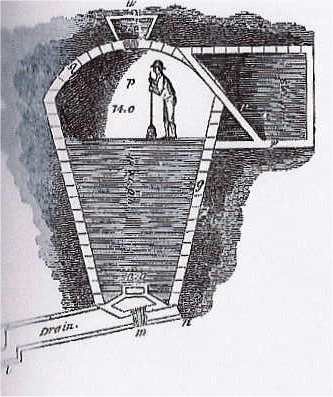In the film Persuasion with Amanda Root,Anne is seen eating ices in the dining room at Kellynch. The reason Elizabeth makes the point about it being the last of the ice (cream or sorbet) till next winter, is that in grand estates of the 18th century and early 19th century ice was harvested and kept in ice houses,especially built for the purpose.
They were usually situted near to a lake so that when the lake froze the ice transported to the house till it was used or melted.It could take up to 13 months to melt.
As you can see from the diagram below these houses were constructed so that the main part of the storage area was below ground for inslulating purposes. The one at Godmersham , home of JA’s brother, Edward Austen Knight, was also shaded by tress grown around the entrance mound of the ice house .
Ice houses were usually filled with fresh ice every winter.They were usually situated near a pond or a lake,such as the one still extant at Holkham Hall, Norfolk. Once the lake froze in winter the gardeners would break the ice and take it by cart to the ice house,where it was pounded by mallets into a powder,and then rammed down into the ice house to form a solid mass.A lining of staw was usually put between the wall of the ice house and the ice to insulate it. The entrance lobby was simularly insulated with straw.
Once it was empty of ice in late summer it would have been used as a temporary store for root vegetables.Do note that ice houses were not used for the preservation of frozen food in our era.They were used for the preservation of ice! It was not until after Jane Austen’s life time around 1820, that it was realised that the ice house could be used as a very simple freezer,and could preserve fruit such as cherries,strawberries,raspberries and peaches.
A better name for these buildings was an Ice Well- this was the term used in the 1660’s when they were first introduced into England from Italy.I think its a much better description,as most of the building is under ground to better insulate it.

Above is a picture of a side section of an ice house designed by Alexander Jamison in 1838 (a little out of our time period but it gives you some idea of the construction).
Ice from thes ice houses was used to make sorbets and ice creams.
Below I have linked recipes for Georgian ices from Ivan Day’s fabulous Historic Food website. You might be surprised at the ” modern-ness ” of some of the ingredients 😉
Interstingly, in another scene in Persuasion ( and one which was included in P2) Anne, Elizabeth and Mrs Clay are seen eating marzipan cakes in Mollands the confectioners, which did exist at Number 2, Milsom Street in Bath. Most confectioners also sold ices,and so they could have been eating ice cream or sorbet too.
A good book on this subject, for further reading, is Elizabeth David’s Harvest of the Cold Months; A Social History of Ice and Ices .
Here is a recipie from my copy of Mrs Rundell’s cookery book, A New System of Domestic Cookery published in 1816, for fruit ice cream, which gives details of the “ice cream maker” in use at the time” :
Get a few pounds of ice, break it almost to powder, throw a large handful and a half of salt among it. You must prepare it in a part of the house where as little of the warm air comes as you can possibly contrive.
The ice and salt being in a bucket, put your cream into an ice-pot, and cover it; immerse it in the ice, and draw that round the pot ,so as to touch every possible part.
In a few minutes put a spatula or spoon in , and stir it well, removing the parts that ice round the edge to the centre. If the ice cream, or water, be in a form, shut the bottom close, and move the whole in the ice, as you cannot use a spoon to that without danger of waste. There should be holes in the bucket, to let off the ice as it thaws.
Note: When any fluid tends towards cold, the moving of it quickly accelerates the cold; and likewise, when any fluid is tending to heat, stirring it will facilitate its boiling.
**********************************************
Ice Creams.
Mix the juice of the fruits with as much sugar as will be wanted, before you add cream, which should be of middling richness.
